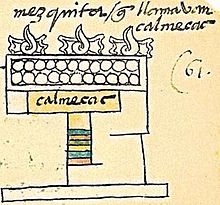Calmecac

The Calmecac ("the house of the lineage", [kalˈmekak]) was a school for the sons of Aztec nobility (pīpiltin [piːˈpiɬtin]) in the Late Postclassic period of Mesoamerican history, where they would receive rigorous religious and military training. The calmecac tied together the military, political and sacred hierarchies of the community.[1] The two main primary sources for information on the calmecac and telpochcalli are in Bernardino de Sahagún's Florentine Codex of the General History of the Things of New Spain (Books III, VI, and VIII) and part 3 of the Codex Mendoza.[2] Although the calmecac has been characterized as for elites only, Sahagun's account says that at times commoners, macehualtin were assigned to the calmecac as well and trained for the priesthood.[3][4] The Tēlpochcalli ([teːɬpot͡ʃˈkalːi] "house of youth") was where mostly commoners and some noble youths received military training, but would have been precluded from the higher ranks of power.[5] Codex Mendoza's account of the calmecac emphasizes the possibilities of upward mobility for young commoner men, (macehualtin), educated in the telpochcalli. The placement of noble youth in the telpochcalli might have been by lesser wives' or concubines' sons or younger sons, perhaps of commoner status so that the boys did not have to compete with noble youths in the calmecac.[6] Codex Mendoza's account largely ignores class distinctions between the two institutions.[7]
The calmecac of the Aztec capital, Tenochtitlan, was located in the ceremonial centre of the city and it was dedicated to Quetzalcoatl.[8]
The calmecac was the students' home for the duration of their training, and they would enter the school as young as five to seven years of age. The students received instruction in songs, rituals, reading and writing, the calendar (tōnalpōhualli [toːnaɬpoːˈwalːi]) and all the basic training which was also taught in the telpochcalli.
Students commenced formal military training around age fifteen.[9]
Promising sons of nobles would be trained especially by the military orders of the Jaguar warriors (ōcēlōmeh [oːseːˈloːmeʔ]) or Eagle warriors (cuāuhtin [ˈkʷaːʍtin]) in their quarters, the cuāuhcalli ([kʷaːʍˈkalːi]).[10]
Notes
- ^ Carrasco, Pedro. (2001). "Calmecac". In Davíd Carrasco (ed). The Oxford Encyclopedia of Mesoamerican Cultures, vol 1. New York : Oxford University Press.
- ^ Edward Calneck, "The Calmecac and Telpochcalli in Pre-Conquest Tenochtitlan," in The Work of Bernardino de Sahagún: Pioneer Ethnographer of Sixteenth-Century Aztec Mexico, J. Jorge Klor de Alva et al., eds. Albany: SUNY Albany Institute for Mesoamerican Studies 1988, p. 170.
- ^ Edward Calneck, "The Calmecac and Telpochcalli" p. 169.
- ^ Hassig (1988), p.34.
- ^ Calnek, "Calmecac and Telpochcalli", p. 169.
- ^ Calnek, "Calmecac and Telpochcalli", p. 176.
- ^ Calnek, "Calmecac and Telpochcalli", p. 177.
- ^ Hassig (1988), p.34.
- ^ Hassig (1988), p.35.
- ^ Hassig (1988), p.36.
References
- Aguilar-Moreno, Manuel (2007). Handbook to Life in the Aztec World. Oxford and New York: Oxford University Press. ISBN 978-0-19-533083-0. OCLC 81150666.
- Andrews, J. Richard (2003). Introduction to Classical Nahuatl (revised ed.). Norman: University of Oklahoma Press. ISBN 0-8061-3452-6. OCLC 50090230.
- Calnek, Edward. "The Calmecac and Telpochcalli in Pre-Conquest Tenochtitlan" in The Work of Bernardino de Sahagún: Pioneer Ethnographer of Sixteenth-Century Aztec Mexico, J. Jorge Klor de Alva et al., eds. Albany: SUNY Albany Institute for Mesoamerican Studies 1988.
- Carrasco, Pedro. "Calmecac". In Davíd Carrasco (ed). The Oxford Encyclopedia of Mesoamerican Cultures, vol 1. New York : Oxford University Press, 2001. ISBN 9780195108156
- Hassig, Ross (1988). Aztec Warfare: Imperial Expansion and Political Control. Civilization of the American Indian series, no. 188. Norman: University of Oklahoma Press. ISBN 0-8061-2121-1. OCLC 17106411.
- León-Portilla, Miguel (1980). Native Mesoamerican Spirituality: Ancient myths, discourses, stories, doctrines, hymns, poems from the Aztec, Yucatec, Quiché-Maya and other sacred traditions. New York: Paulist Press. ISBN 0-8091-0293-5. OCLC 6450751.
- Sahagún, Bernardino de (1997) [ca.1558–61]. Primeros Memoriales. Civilization of the American Indians series vol. 200, part 2. Thelma D. Sullivan (English trans. and paleography of Nahuatl text), with H.B. Nicholson, Arthur J.O. Anderson, Charles E. Dibble, Eloise Quiñones Keber, and Wayne Ruwet (completion, revisions, and ed.). Norman: University of Oklahoma Press. ISBN 978-0-8061-2909-9. OCLC 35848992.
- Van Tuerenhout, Dirk R. (2005). The Aztecs: New Perspectives. ABC-CLIO's understanding ancient civilizations series. Santa Barbara, CA: ABC-CLIO. ISBN 1-57607-921-X. OCLC 57641467.
